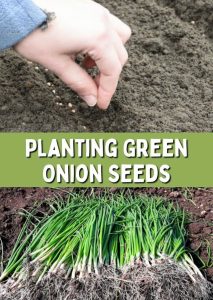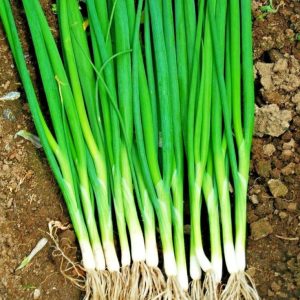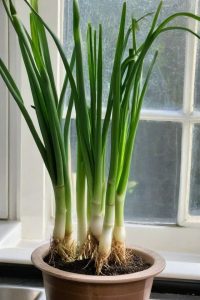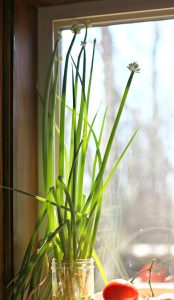Learn how to grow green onions from seeds successfully with DH Landscape Solutions. Discover expert tips on soil preparation, planting, care, and harvesting in Canada. Shop high-quality seeds, compost, and gardening supplies today!

If you’re looking to grow green onions (scallions) successfully, preparation is key. At DH Landscape Solutions, we provide expert guidance and high-quality supplies to ensure your gardening success. Whether you’re an urban gardener or managing a large backyard, having the right materials and techniques will help your green onions thrive in Canada’s climate.
Essential Supplies for Growing Green Onions
To give your green onions the best start, ensure you have the following essential supplies:
1. High-Quality Green Onion Seeds
Choosing the right seeds is crucial for a successful harvest. Opt for organic, non-GMO varieties suited for Canadian climates. Some recommended varieties include:
- Evergreen Hardy White – Cold-resistant, ideal for overwintering.

- Tokyo Long White – Long, slender stalks with a mild flavor.

- Parade – Fast-growing with a vibrant green color, perfect for continuous harvesting.

2. Premium Soil and Compost
Green onions thrive in nutrient-rich, well-draining soil. Use a mix of high-quality garden soil and compost to enhance fertility. Compost adds essential nutrients and improves soil texture, ensuring strong root development.
3. Raised Beds or Containers
- Raised Beds: Offer excellent drainage and soil control, preventing waterlogging.
- Containers: Ideal for small spaces, requiring a depth of at least 6 inches. Ensure pots have drainage holes to prevent root rot.
4. Organic Fertilizers
Green onions require a steady nutrient supply. A balanced organic fertilizer with equal nitrogen, phosphorus, and potassium (such as 10-10-10) promotes strong leaf growth and healthy roots. Compost tea and worm castings are also great natural options.
5. Mulch
Applying mulch helps retain moisture, regulate soil temperature, and suppress weeds. Use organic mulch like straw, shredded leaves, or grass clippings to maintain ideal soil conditions.
6. Row Covers
Protecting young plants from pests and extreme weather conditions is essential for their survival. Floating row covers shield plants from insect infestations and sudden temperature fluctuations.
7. Garden Tools
Having the right tools makes gardening easier. Equip yourself with:
- Small trowels for transplanting seedlings.
- Watering cans with a fine mist setting to gently hydrate young plants.
- Hand rakes to aerate and loosen the soil before planting.
8. Grow Lights (For Indoor Growing)
If growing indoors or extending the growing season, invest in LED grow lights. Green onions require 12-14 hours of light daily for optimal growth. Position lights 6-12 inches above the plants and adjust as they grow.
By gathering these essentials before planting, you set yourself up for a successful green onion harvest. Now that you have your supplies, let’s move on to preparing your garden or container for planting!
Choosing the Best Soil for Green Onions
Green onions require loose, well-aerated soil rich in organic matter. Ensuring proper soil preparation is crucial for strong root development and healthy growth.
1. Test and Amend Soil
Green onions prefer slightly acidic to neutral soil with a pH range of 6.0-7.0. Before planting, test the soil using a pH meter or soil test kit. If the pH is too low (acidic), amend it with garden lime. If it’s too high (alkaline), add sulfur or peat moss to balance it.
Additionally, enrich the soil with well-rotted compost or aged manure to provide essential nutrients and improve soil texture.
2. Improve Drainage
Excess water can lead to root rot, which weakens plants and reduces yield. To enhance drainage:
- Use raised beds, which allow excess water to drain away efficiently.
- Add perlite or sand to heavy clay soil to increase aeration and prevent waterlogging.

- Avoid planting in low-lying areas prone to water accumulation.
3. Enhance Fertility
Green onions thrive in nutrient-rich soil. Incorporate a balanced organic fertilizer (such as 10-10-10) before planting to ensure adequate nitrogen, phosphorus, and potassium levels. Compost and worm castings can also enhance fertility, encouraging steady growth.
4. Aerate the Soil
Compacted soil restricts root expansion, leading to stunted growth. To improve aeration:
- Loosen the soil 8-10 inches deep using a garden fork or tiller.
- Avoid excessive tilling, which can disrupt beneficial soil organisms.
- Rotate crops annually to prevent soil depletion and maintain soil structure.
5. Boost Microbial Life
Healthy soil is rich in beneficial microbes, which aid nutrient absorption and root health. To boost microbial activity:
- Apply compost tea to introduce beneficial bacteria and fungi.

- Use mycorrhizal fungi to enhance root systems and improve nutrient uptake.
- Avoid chemical pesticides and fungicides, which can harm soil microbes.
By following these soil preparation techniques, you create the optimal environment for green onions to grow vigorously and produce high yields. Now that your soil is ready, let’s move on to sowing the seeds! Green onions can be grown in traditional garden beds, raised beds, or containers. The key to success is well-prepared soil.
- Outdoor Growing: Choose a sunny location with at least 6 hours of direct sunlight per day. Loosen the soil and remove weeds before planting.
- Container Growing: Use a pot at least 6 inches deep with drainage holes. A mixture of compost, potting soil, and perlite provides the best growth medium.
- Raised Beds: These offer better soil control and drainage, which is especially beneficial in regions with heavy rainfall.
Before planting, enrich the soil with compost and a balanced organic fertilizer to promote healthy root development.
Step-by-Step Guide to Growing Green Onions
Step 1: Selecting the Right Seeds
Choosing the right variety is crucial for success. Green onions come in several varieties, and selecting the best one for your climate ensures a healthy harvest.
- Evergreen Hardy White – Ideal for cold climates, this variety is resistant to frost and produces strong, flavorful stalks.
- Tokyo Long White – This variety is known for its long, slender stalks and mild flavor, perfect for salads and stir-fries.
- Parade – A fast-growing, vibrant green onion that provides a continuous harvest.
When selecting seeds, opt for organic, non-GMO varieties that are suited to the Canadian growing season. Look for reputable seed suppliers or visit DH Landscape Solutions for high-quality seeds.
Step 2: Preparing the Garden or Container
Green onions can be grown in traditional garden beds, raised beds, or containers. The key to success is well-prepared soil.
- Outdoor Growing: Choose a sunny location with at least 6 hours of direct sunlight per day. Loosen the soil and remove weeds before planting.
- Container Growing: Use a pot at least 6 inches deep with drainage holes. A mixture of compost, potting soil, and perlite provides the best growth medium.
- Raised Beds: These offer better soil control and drainage, which is especially beneficial in regions with heavy rainfall.
Before planting, enrich the soil with compost and a balanced organic fertilizer to promote healthy root development.
Step 3: Sowing the Seeds
Planting green onion seeds correctly ensures a high germination rate and strong growth.
- Spacing and Depth – Sow seeds 1/4 inch deep in rows spaced 2 inches apart.
- Soil Coverage – Lightly cover with a fine layer of soil and press gently to ensure good seed-to-soil contact.
- Watering – Use a gentle spray or mist to keep the soil moist but not soggy.
- Germination Period – Seeds typically germinate within 7-14 days. Keep the soil consistently moist during this time.
Step 4: Caring for Young Seedlings
Once seedlings emerge, proper care is essential for strong growth.
- Watering: Keep the soil evenly moist but avoid waterlogging, as excess moisture can cause root rot.
- Thinning: When seedlings are about 2 inches tall, thin them to 1-2 inches apart to allow space for growth.
- Protection: Use row covers to shield young plants from pests and harsh weather conditions.
Step 5: Fertilization and Mulching
Green onions benefit from a consistent supply of nutrients throughout their growth cycle.
- Organic Fertilizers: Apply compost tea or a balanced organic fertilizer every 3-4 weeks to promote steady growth.
- Mulching: A thin layer of organic mulch, such as straw or compost, helps retain moisture and suppress weeds.
- Avoid Over-Fertilization: Excess nitrogen can lead to weak, floppy leaves. Stick to balanced feeding practices.
Step 6: Pest and Disease Management
Green onions are relatively low-maintenance but can be susceptible to pests and diseases.
- Common Pests:
- Aphids & Thrips: Can be controlled with neem oil or insecticidal soap.
- Onion Maggots: Prevent infestations by using row covers and rotating crops each season.
- Fungal Diseases:
- Avoid overhead watering and ensure plants are well-spaced for air circulation.
- Use an organic fungicide if necessary.
Step 7: Harvesting Techniques
Harvesting green onions at the right time ensures a flavorful and continuous supply.
- Early Harvest: When plants reach 6-8 inches tall, trim the green tops for a mild flavor while allowing regrowth.
- Full Harvest: Pull the entire plant when it has matured, usually 8-10 weeks after planting.
- Regrowth Method: Leave the roots in the soil after trimming the tops. Green onions will continue to grow back multiple times.
- Storage Tips: Store harvested green onions in a damp paper towel inside a plastic bag in the refrigerator to maintain freshness.
Advanced Growing Techniques
Indoor Growing for Year-Round Harvest
- Use grow lights to ensure adequate light (12-14 hours per day).
- Choose self-watering containers for consistent moisture.
- Maintain indoor temperatures around 18-22°C (65-72°F).
Hydroponic Green Onion Farming
- Use nutrient-rich hydroponic solutions for faster growth.
- Ensure oxygenation of roots using an air pump.
- Harvest continuously without soil-based pests.
Greenhouse Cultivation
- Extends the growing season in colder regions.
- Provides temperature control and pest protection.
- Allows for multi-layer vertical gardening.
Troubleshooting Common Green Onion Issues
| Issue | Cause | Solution |
|---|---|---|
| Yellowing Leaves | Overwatering, poor drainage | Water less frequently, improve soil drainage |
| Stunted Growth | Lack of nutrients | Apply organic compost or fertilizers |
| Bolting (flowering) | High temperatures, plant stress | Provide shade during hot months, mulch well |
| Pests (aphids, onion maggots) | Poor plant spacing, excess moisture | Use row covers, neem oil, and proper ventilation |
Harvesting and Enjoying Your Green Onions
Green onions grow quickly and can be harvested multiple times. Follow these harvesting tips:
- Early Harvesting: Cut the green tops when they reach 6 inches tall for a mild flavor.
- Full Harvest: Uproot the entire plant once fully matured.
- Regrowth Technique: Trim leaves above the base to encourage regrowth for continuous production.
- Storage Tips: Store harvested green onions in a damp paper towel inside a plastic bag in the refrigerator for longer freshness.
Exclusive Offer from DH Landscape Solution

Whether you’re planning backyard landscaping, green landscaping, or need help with Landscaping Services, DH Landscape Solution ensures your garden flourishes. Get ahead in your Landscaping Services with DH Landscape Solution. Recognized as the best landscaping company and the best landscaping company in Vancouver, we offer unparalleled expertise to help you achieve your gardening and landscaping goals. For a limited time, enjoy a free Landscaping Services Consultation and receive 20% off. Whether you’re planning backyard landscaping or need expert advice for landscaping services, we’re here to help. Contact us today to claim your voucher and take the first step toward greener gardening.
Start your garden with confidence—choose DH Landscape Solutions for all your gardening needs!

